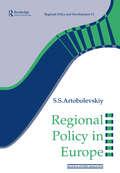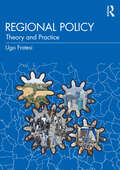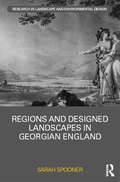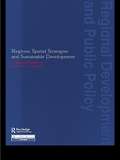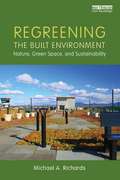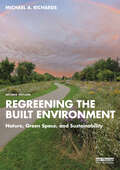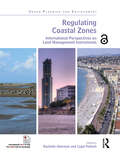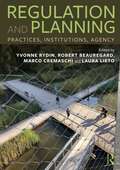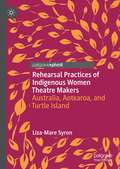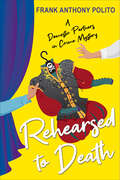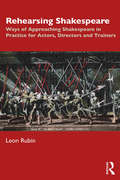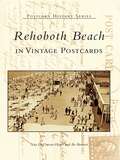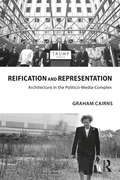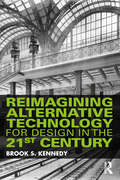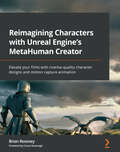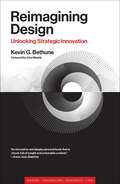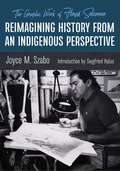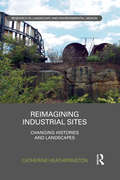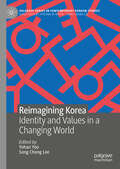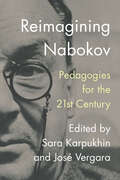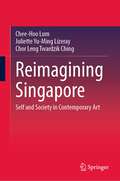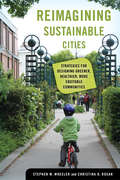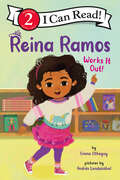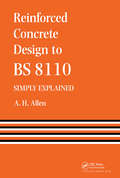- Table View
- List View
Regional Policy in Europe (Regions and Cities #Vol. 11)
by S.S ArtobolevskiyBased on the author's extensive research in the field, this book analyzes regional policy for the whole of Europe. Comparing East and West, it offers a new model of regional policy and gives an overview of the direction that it may take in Europe as a whole. Topics covered include: the evaluation of regional policy; its main aims; its "infrastructure" in Western Europe; its form in Eastern Europe; and the development of regional policy from 1917 to the 1990s. The book is intended for professionals and academics working in the areas of regional studies, economics and policy studies.
Regional Policy: Theory and Practice
by Ugo FratesiRegional policy is an essential in any government’s toolkit for promoting socioeconomic prosperity. It comes in many forms and can be used to target the development of weak and stronger regions. This textbook provides comprehensive and systematic coverage of regional policy, dealing with core theories and looking at contemporary challenges in practice, addressing regional policy across the world. Structured in four parts, the book opens with an exploration of regional policy’s characterisation, aims and rationale. The second part is devoted to issues of implementation and the instruments available to policymakers for intervention. The third part addresses regional policy evaluation, as well as statistics and modelling in policymaking. Finally, the book discusses how regional policy is applied in different contexts. Each chapter contains real-life examples of a regional policy topic in action and highlights supplementary topics for advanced readers. With its broad coverage of the subject, Regional Policy: Theory and Practice will prove a valuable resource for advanced students, researchers and practitioners in regional policy, regional economics, economic geography, planning and public policy.
Regions and Designed Landscapes in Georgian England (Routledge Research in Landscape and Environmental Design)
by Sarah SpoonerGarden design evolved hugely during the Georgian period – as symbols of wealth and stature, the landed aristocracy had been using gardens for decades. Yet during the eighteenth century, society began to homogenise, and the urban elite also started demanding landscapes that would reflect their positions. The gardens of the aristocracy and the gentry were different in appearance, use and meaning, despite broad similarities in form. Underlying this was the importance of place, of the landscape itself and its raw material. Contemporaries often referred to the need to consult the ‘genius of the place’ when creating a new designed landscape, as the place where the garden was located was critical in determining its appearance. Genius loci - soil type, topography, water supply - all influenced landscape design in this period. The approach taken in this book blends landscape and garden history to make new insights into landscape and design in the eighteenth century. Spooner’s own research presents little-known sites alongside those which are more well known, and explores the complexity of the story of landscape design in the Georgian period which is usually oversimplified and reduced to the story of a few ‘great men’.
Regions, Spatial Strategies and Sustainable Development (Regions and Cities)
by Graham Haughton David CounsellFocusing on recent regional policy and important planning debates across the English regions, this book analyzes the issues, disputes and tensions that have arisen in regional planning in the new millennium. With a range of local case studies to ground the argument in local as well as regional planning, the authors here build on a range of theoretical insights including state theory and governance, political ecology, governmentality and collaborative planning. Drawing particularly on a discourse approach, the empirical sections examine a range of major controversies from the past five years of regional planning, including: the socio-political resistance to new housing on Greenfield sites alternative approaches to promoting sustainable urban development and policies for urban renaissance policies on redirecting or constraining economic expansion in high-pressure growth areas the social and political bases of new planning technologies for protecting the environment, including sustainability appraisals.
Regreening the Built Environment: Nature, Green Space, and Sustainability
by Michael A RichardsRegreening the Built Environment examines the relationship between the built environment and nature and demonstrates how rethinking the role and design of infrastructure can environmentally, economically, and socially sustain the earth. In the past, infrastructure and green or park spaces have been regarded as two opposing factors and placed in conflict with one another through irresponsible patterns of development. This book attempts to change this paradigm and create a new notion that greenspace, parks, and infrastructure can indeed be one in the same. The case studies will demonstrate how existing "gray" infrastructure can be retrofitted with green infrastructure and low impact development techniques. It is quite plausible that a building can be designed that actually creates greenspace or generates energy; likewise, a roadway can be a park, an alley can be a wildlife corridor, and a parking surface can be a garden. In addition to examining sustainability in the near future, the book also explores such alternatives in the distant and very distant future, questioning the notion of sustainability in the event of an earth-altering, cataclysmic disaster. The strategies presented in this book aim to stimulate discussions within the design profession and will be of great interest to students and practitioners of environmental studies, architecture, and urban design.
Regreening the Built Environment: Nature, Green Space, and Sustainability
by Michael A. RichardsNow in its second volume, Regreening the Built Environment provides an overview of physical and social environmental challenges that the planet is facing and presents solutions that restore ecological processes, reclaim open space, foster social equity, and facilitate a green economy.Healing the planet requires a combination of strategies networked across multiple scales of development, including buildings, sites, communities, and regions. Case studies from a range of locations in the United States, Denmark, Vietnam, Germany, South Korea, Switzerland, France, and the United Kingdom, among others, demonstrate how existing gray infrastructure can be retrofitted with green infrastructure and low-impact development techniques. From this, the author shows how a building can be designed that creates greenspace or generates energy; likewise, a roadway can be a parkway, an alley can be a wildlife corridor, and a parking surface can be a garden. This new edition also includes case studies that have successfully reconnected communities that were fragmented by unjust planning practices and irresponsible patterns of development, resilient design solutions in response to natural disasters, passive design strategies that can make interior spaces more efficient and healthier, and expanded discussions on capturing carbon, renewable energy, agriculture, waste, public transit, and adaptive reuse, including innovative ideas on how to reimagine the shopping mall in the era of e-commerce.The strategies presented in this book will stimulate discussions within the design profession and will be of great interest to students and practitioners of environmental studies, architecture, landscape architecture, and urban design.
Regulating Coastal Zones: International Perspectives on Land Management Instruments (Urban Planning and Environment)
by Rachelle Alterman Cygal PellachRegulating Coastal Zones addresses the knowledge gap concerning the legal and regulatory challenges of managing land in coastal zones across a broad range of political and socio-economic contexts. In recent years, coastal zone management has gained increasing attention from environmentalists, land use planners, and decision-makers across a broad spectrum of fields. Development pressures along coasts such as high-end tourism projects, luxury housing, ports, energy generation, military outposts, heavy industry, and large-scale enterprise compete with landscape preservation and threaten local history and culture. Leading experts present fifteen case studies among advanced-economy countries, selected to represent three groups of legal contexts: signatories to the 2008 Mediterranean ICZM Protocol, parties to the 2002 EU Recommendation on Integrated Coastal Zone Management, and the USA and Australia. This book is the first to address the legal-regulatory aspects of coastal land management from a systematic cross-national comparative perspective. By including both successful and less-effective strategies, it aims to inform professionals, graduate students, policy makers, and NGOs of the legal and socio-political challenges as well as the better practices from which others could learn.
Regulation and Planning: Practices, Institutions, Agency
by Yvonne Rydin Laura Lieto Robert Beauregard Marco CremaschiIn Regulation and Planning, planning scholars from the United Kingdom, France, Italy, Sweden, Canada, Australia, and the United States explore how planning regulations are negotiated amid layers of normative considerations. It treats regulation not simply as a set of legal guidelines to be compared against proposed actions, but as a social practice in which issues of governmental legitimacy, cultural understandings, materiality, and power are contested. Each chapter addresses an actual instance of planning regulation including, among others, a dispute about a proposed Apple store in a public park in Stockholm, the procedures by which building codes are managed by planners in Napoli, the role that design plays in regulating the use of public space in a new Paris neighbourhood, and the influence of plans on the regulation of development in Malmö and Cambridge. Collectively, the volume probes the institutions and practices that give meaning and consequence to planning regulations. For planning students learning about what it means to plan, planning researchers striving to understand the influence of planners on urban development, and planning practitioners interested in reflecting on practices that occupy a great deal of their time, this is an indispensable book.
Rehearsal Practices of Indigenous Women Theatre Makers: Australia, Aotearoa, and Turtle Island
by Liza-Mare SyronThis transnational and transcultural study intimately investigates the theatre making practices of Indigenous women playwrights from Australia, Aotearoa, and Turtle Island. It offers a new perspective in Performance Studies employing an Indigenous standpoint, specifically an Indigenous woman’s standpoint to privilege the practices and knowledges of Maori, First Nations, and Aboriginal women playwrights. Written in the style of ethnographic narrative the author affords the reader a ringside seat in providing personal insights on the process of negotiating access to rehearsals in each specific cultural context, detailed descriptions of each rehearsal location, and describing the visceral experiences of observing Indigenous theatre makers from inside the rehearsal room. The Indigenous scholar and theatre maker draws on Rehearsal Studies as an approach to documenting the day-to-day working practices of Indigenous theatre makers and considers an Indigenous Standpoint as a valid framework for investigating contemporary Indigenous theatre practices in a colonised context.
Rehearsed to Death (A Domestic Partners in Crime Mystery #2)
by Frank Anthony PolitoAward-winning author and playwright Frank Anthony Polito continues his debut cozy mystery series featuring a gay couple who solve crimes while renovating houses as part of their hit reality show Domestic Partners. Set in suburban Detroit, it's Hart to Hart via HGTV! The perfect combination for fans of home repair and cozy mysteries. Peter&’s first play is having its world premiere at Pleasant Woods&’s community theater. His handsome one and only, JP, has the lead. Rehearsals have begun. And New York City&’s award-winning, hotshot helmer, Xander Sherwood Deva, is directing. Unfortunately the controlling, arrogant, poison-barbed, egomaniacal diva has everyone on edge. No wonder he finallypushes someone over it . . . Xander is found strangled to death in the same extra-long, imported cashmere scarf he&’s been brandishing like a boa ever since he arrived. In the name of making art he&’s burned a lot of bridges and made a lot of enemies but which one wanted to bring down the curtain on him? As they say in the theater: the show must go on. But not before amateur sleuths Peter and JP become Domestic Partners in Crime and try to solve this deadly real-life drama ahead of opening night. Praise for Renovated to Death &“Quirky [and] humorous.&” —Kirkus Reviews &“A fast, fun read—with bonus renovating tips!&”--Laura Levine, author of Death by Smoothie
Rehearsing Shakespeare: Ways of Approaching Shakespeare in Practice for Actors, Directors and Trainers
by Leon RubinRehearsing Shakespeare offers a dynamic guide to practice in rehearsals and workshops for actors, directors and trainers in a UK and global context. The book analyses the roots and development of modern-day approaches to Shakespeare and applies theory of verse analysis to practical work, ranging from the drama student to the highest professional level in major global theatres. At the heart of the book are a series of carefully tested acting exercises, worked with professional actors and drama students across the world, both in English and in translation. Featuring several case studies from the author’s own work and the work of others, it explores how acting and directing relate to design and other forms of artistic collaboration during Shakespeare production. An excellent resource for students and teachers of acting and directing courses, drama and English literature students at all levels, new professional actors and professional actors undertaking the exciting task of acting and directing Shakespeare at an international level, Rehearsing Shakespeare offers practical approaches to cutting and editing through to the core challenges of any Shakespearian play.
Rehoboth Beach in Vintage Postcards (Postcard History Series)
by Bo Bennett Nan Devincent-HayesRehoboth Beach is heralded as the "nation's summer capital." Located along the Atlantic Coast within 100 miles of Washington, D.C., Baltimore, and Philadelphia, Delaware's treasured resort has provided millions of tourists with unforgettable memories along its mile-long boardwalk and white, sandy beach. Vintage postcards and photographs will allow readers to experience the thrill of this renowned beach and see why many have made Rehoboth their choice for vacations, holidays, and getaways time and time again-and why some call it home year-round. This photo album features then-and-now scenes of the beach, documents the rise of other attractions surrounding the area, pays homage to storms that shook the seacoast, and showcases some of the people, festivals, hotels, and motels that make this a special place to visit.
Reification and Representation: Architecture in the Politico-Media-Complex (Routledge Research in Architecture)
by Graham CairnsThe relationship between politics and the public relations industry is controversial and, at times, polemic. However, one component of this relationship that has yet to be investigated is the role of architecture. Arguing for a fundamental reconfiguration of our understanding of ‘political architecture’, this book suggests it is not only a question of constructed buildings, but equally a case of mediated imagery. Considered through examples of architecture as a backdrop for photo shoots by politicians in the democracies of the United States and the United Kingdom, this book suggests these images give us both a better understanding of recent developments in the Western political economy and the architectural and urban developments of the late 20th and early 21st Centuries. Using case studies of Margaret Thatcher, Tony Blair, David Cameron, Barack Obama, George W. Bush and Donald Trump, this book represents a ground-breaking triangular analysis that will be essential reading for scholars in architecture, politics, media and communication studies.
Reimag(in)ing the Victorians in Contemporary Art: Britain and Beyond
by Isobel ElstobFrom contemporary deployments of taxidermy, magic lanterns and microscopy to the visualization of forgotten lives, marginalized narratives and colonial histories, this book explores how the work of artists including Mat Collishaw, Yinka Shonibare, Tessa Farmer, Mark Dion, Dorothy Cross and Ingrid Pollard reimag(in)es the Victorians in the ‘present’. Examining how recent paintings, sculptures, photographs, installations and films revisit and re-present nineteenth-century technologies, practices and events, the book’s rich interdisciplinary approach applies literary, media and linguistic theories to its analysis of visual art, alongside in-depth discussions of the Victorian inventions, concepts and narratives that they invoke. The book’s emphasis on how – and why – we represent the historical past makes its contribution particularly timely. And by drawing attention to the importance of historiography to the work of these artists, it also unravels the complicated history of History itself. This book will speak to diverse audiences including those interested in art history, visual culture, Victorian and neo-Victorian studies, as well as literature, histories of science and media, postcolonialism, museology, gender studies, postmodernism and the history of ideas.
Reimagining Alternative Technology for Design in the 21st Century
by Brook S. KennedyReimagining Alternative Technology for Design in the 21st Century presents a new approach to design that harnesses still-valuable alternative, traditional and abandoned technologies alongside the creation of new ones to address contemporary global problems. It focuses on design opportunities that reduce energy and material consumption to tackle issues such as climate change and pollution in industrialized economies. The book takes the reader on a journey surveying different facets of human activity to identify underused and discarded technologies that could be indispensable today. It critically addresses newer approaches to design and technology by comparing them to existing alternatives, unpacking examples including air conditioning with smart thermostats, electric lighting, durable reusable products, domestic maintenance tools and methods of transportation. Written for practicing designers and students in industrial design, architecture, sustainable design and human-centered design, this book provides new ideas and tools for creating more useful, energy-and-resource-efficient product designs and systems.
Reimagining Characters with Unreal Engine's MetaHuman Creator: Elevate your films with cinema-quality character designs and motion capture animation
by Brian Rossney Ciaran KavanaghDiscover the power of Unreal Engine 5 and the MetaHuman Creator to develop realistic digital characters, infusing them with full body and facial animationKey FeaturesCreate realistic characters using the MetaHuman Creator using a mixture of preset and custom toolsImport your character into Unreal Engine 5 to access more editing options and begin animating itCombine face and body motion capturing to fully animate your digital humansBook DescriptionMetaHuman Creator (MHC) is an online, user-friendly 3D design tool for creating highly realistic digital humans that can be animated within Unreal Engine (UE) and enhanced with motion capture technology. This means that filmmakers and game developers now have access to a high quality, affordable solution that was previously only available to specialist studios. This book will focus on using UE5 and MHC from a filmmaker angle. Firstly, you'll understand how to use the online MHC to create a digital character, changing its facial structure, body type, and clothing. After that, you'll learn all the necessary steps to bring the character into UE5 and set it up for animation. Then, using an iPhone and a webcam to capture face and body movements, you'll mix these motion capture files, refine the animations using the MetaHuman Control Rig, and save these takes to be reused and edited again within the Level Sequencer. On top of that, you'll learn how to create a rendered video file for film production using both the Level Sequencer and a VR Cinematic Camera. By the end of this book, you'll have created your own MetaHuman character, as well as face and body motion capture data, and learned the necessary skills to give your future projects further realism and creative control.What you will learnCreate your own bespoke character using MHCDevelop custom faces based on real peopleUtilize Blueprints to take control of your digital characterRetarget animations using the Unreal MannequinUse DeepMotion and Live Link for complete body and face animationUse the Control Rig to refine animationsExport and render your characterWho this book is forThis book is for filmmakers and hobbyists who are planning to make a film using Unreal Engine for the first time, having worked in live action or purely digital media previously, either professionally or as a hobby. No experience with Unreal Engine is required, however it is useful to have some knowledge of 3D development applications and concepts like wireframes, skin weights, transform tools, and motion capture. It is recommended that you have access to an iPhone X (or a later model). Alternatively, you can use a free or paid version of Faceware, along with a basic webcam.
Reimagining Design: Unlocking Strategic Innovation (Simplicity: Design, Technology, Business, Life)
by Kevin G. BethuneThe power of transformative design, multidisciplinary leaps, and diversity: lessons from a Black professional&’s journey through corporate America.Design offers so much more than an aesthetically pleasing logo or banner, a beautification add-on after the heavy lifting. In Reimagining Design, Kevin Bethune shows how design provides a unique angle on problem-solving—how it can be leveraged strategically to cultivate innovation and anchor multidisciplinary teamwork. As he does so, he describes his journey as a Black professional through corporate America, revealing the power of transformative design, multidisciplinary leaps, and diversity. Bethune, who began as an engineer at Westinghouse, moved on to Nike (where he designed Air Jordans), and now works as a sought-after consultant on design and innovation, shows how design can transform both individual lives and organizations. In Bethune&’s account, diversity, equity, and inclusion emerge as a recurring theme. He shows how, as we leverage design for innovation, we also need to consider the broader ecological implications of our decisions and acknowledge the threads of systemic injustice in order to realize positive change. His book is for anyone who has felt like the &“other&”—and also for allies who want to encourage anti-racist, anti-sexist, and anti-ageist behaviors in the workplace. Design transformation takes leadership—leaders who do not act as gatekeepers but, with agility and nimbleness, build teams that mirror the marketplace. Design in harmony with other disciplines can be incredibly powerful; multidisciplinary team collaboration is the foundation of future innovation. With insight and compassion, Bethune provides a framework for bringing this about.
Reimagining History from an Indigenous Perspective: The Graphic Work of Floyd Solomon
by Joyce M. SzaboFew contemporary artists before the 1990s explored the negative impact of the Spanish in the Southwest, but unreflective celebrations of the Columbus Quincentennial brought about portrayals of a more complicated legacy of Columbus&’s arrival in the Americas—especially by Indigenous artists. Through a series of etchings, Floyd Solomon of Laguna and Zuni heritage undertook a visual recounting of Pueblo history using Indigenous knowledge positioned to reimagine a history that is known largely from non-Native records. While Solomon originally envisioned more than forty etchings, he ultimately completed just twenty. From nightmarish visions of the Spanish that preceded their arrival to the subsequent return of the Spanish and their continuing effects on the Pueblo people, Solomon provides a powerful visual record. These insightful, probing etchings are included in this important full-color volume showcasing Solomon&’s work and legacy. In Reimagining History from an Indigenous Perspective, Joyce M. Szabo positions Solomon among his contemporaries, making this vibrant artist and his remarkable vision broadly available to audiences both familiar with his work and those seeing it for the first time.
Reimagining Industrial Sites: Changing Histories and Landscapes (Routledge Research in Landscape and Environmental Design)
by Catherine HeatheringtonThe discourse around derelict, former industrial and military sites has grown in recent years. This interest is not only theoretical, and landscape professionals are taking new approaches to the design and development of these sites. This book examines the varied ways in which the histories and qualities of these derelict sites are reimagined in the transformed landscape and considers how such approaches can reveal the dramatic changes that have been wrought on these places over a relatively short time scale. It discusses these issues with reference to eleven sites from the UK, Germany, the USA, Australia and China, focusing specifically on how designers incorporate evidence of landscape change, both cultural and natural. There has been little research into how these developed landscapes are perceived by visitors and local residents. This book examines how the tangible material traces of pastness are interpreted by the visitor and the impact of the intangible elements - hidden traces, experiences and memories. The book draws together theory in the field and implications for practice in landscape architecture and concludes with an examination of how different approaches to revealing and reimagining change can affect the future management of the site.
Reimagining Korea: Identity and Values in a Changing World (Palgrave Series in Contemporary Korean Studies)
by Yohan Yoo Song Chong LeeThis volume project explores how evolving values and identities in contemporary Korean society are interpreted, particularly through the lens of religion, positioning it as a window into Korea’s dynamic cultural and social landscape. As Korea grapples with rapid modernization, shifting religious beliefs and expressions reflect new aspects of the Korean people’s values and identity, in both personal and communal dimensions. We believe that this dynamic backdrop creates a complex web of tensions as Koreans negotiate between established norms and newly infused or internally emerging global ideas, inspiring and provoking efforts to navigate and advocate for future directions both within and beyond the country.
Reimagining Nabokov: Pedagogies for the 21st Century
by José Vergara Sara KarpukhinIn Reimagining Nabokov: Pedagogies for the 21st Century, eleven teachers of Vladimir Nabokov describe how and why they teach this notoriously difficult, even problematic, writer to the next generations of students. Contributors offer fresh perspectives and embrace emergent pedagogical methods, detailing how developments in technology, translation and archival studies, and new interpretative models have helped them to address urgent questions of power, authority, and identity. Practical and insightful, this volume features exciting methods through which to reimagine the literature classroom as one of shared agency between students, instructors, and the authors they read together. “It is both timely and refreshing to have an influx of teacher-scholars who engage Nabokov from a variety of perspectives… this volume does justice to the breadth of Nabokov’s literary achievements, and it does so with both pedagogical creativity and scholarly integrity” • Dana Dragunoiu, Carleton University "[A] valuable study for any reader, teacher, scholar, or student of Nabokov. Amongst specific and urgent insights on the potential for digital methods, the relevance of Nabokov for students today, and how to reconcile issues of identity with an author who disavowed history and politics, are much wider and timeless questions of authorial control and the ability to access reality."—Anoushka Alexander-Rose, Nabokov Online Journal Contributions by Galya Diment, Tim Harte, Robyn Jensen, Sara Karpukhin, Yuri Leving, Roman Utkin, José Vergara, Meghan Vicks, Olga Voronina, Lisa Ryoko Wakamiya, and Matthew Walker.
Reimagining Singapore: Self and Society in Contemporary Art
by Chee-Hoo Lum Juliette Yu-Ming Lizeray Chor Leng Twardzik ChingThis book approaches the subject of contemporary art by exploring the social embeddedness and identities of Singaporean artists. Linking artistic processes and production to both personal worlds and wider issues, the book examines how artists negotiate their relationships between self and society and between artistic freedom and social responsibility. It is based on original research into the discourses and artistic practices of local artists, with a special focus on emerging artists and artists whose work and perspectives engage with questions of identity. Reimagining contemporary Singapore and their place within it, artists are asserting their multiple and heterogeneous self-identities and contesting hegemonic norms and notions, as they negotiate and adapt to the world around them. This book is relevant to students and researchers in the fields of cultural studies, media studies, art, sociology of art, arts education, and race and ethnicity studies.
Reimagining Sustainable Cities: Strategies for Designing Greener, Healthier, More Equitable Communities
by Stephen M. WheelerA cutting-edge, solutions-oriented analysis of how we can reimagine cities around the world to build sustainable futures. What would it take to make urban places greener, more affordable, more equitable, and healthier for everyone? In recent years, cities have stepped up efforts to address climate and sustainability crises. But progress has not been fast enough or gone deep enough. If communities are to thrive in the future, we need to quickly imagine and implement an entirely new approach to urban development: one that is centered on equity and rethinks social, political, and economic systems as well as urban designs. With attention to this need for structural change, Reimagining Sustainable Cities advocates for a community-informed model of racially, economically, and socially just cities and regions. The book aims to rethink urban sustainability for a new era. In Reimagining Sustainable Cities, Stephen M. Wheeler and Christina D. Rosan ask big-picture questions of interest to readers worldwide: How do we get to carbon neutrality? How do we adapt to a climate-changed world? How can we create affordable, inclusive, and equitable cities? While many books dwell on the analysis of problems, Reimagining Sustainable Cities prioritizes solutions-oriented thinking—surveying historical trends, providing examples of constructive action worldwide, and outlining alternative problem-solving strategies. Wheeler and Rosan use a social ecology lens and draw perspectives from multiple disciplines. Positive, readable, and constructive in tone, Reimagining Sustainable Cities identifies actions ranging from urban design to institutional restructuring that can bring about fundamental change and prepare us for the challenges ahead.
Reina Ramos Works It Out (I Can Read Level 2)
by Emma Otheguy"A sparkling tale starring a resilient young protagonist" —Kirkus (starred review)Reina Ramos Works It Out is a Level Two I Can Read story about Reina Ramos, a loyal friend whose high-spirited antics sometimes cause chaos, but who always finds a way to make things right. Perfect for social emotional learning!Reina Ramos is excited about dressing up as Frida Kahlo for the class wax museum. Frida was a strong person like her mami and abuela—plus Reina has the perfect headband for the costume! But when her best friend Nora picks Frida first, Reina doesn’t know what to do. Who will she dress up as now?Reina Ramos Works It Out is a Level Two I Can Read book, geared for kids who read on their own but still need a little help. Whether shared at home or in a classroom, the engaging stories, longer sentences, and language play of Level Two books are proven to help kids take their next steps toward reading success.The story also contains several Spanish words, a glossary, and a list of famous people mentioned in the book.“This level 2 beginning reader contains an engaging, relatable story for emergent readers that features simple text, a sprinkling of Spanish vocabulary, and sweet illustrations on each page.” —Booklist"The Spanish words and positive messages about managing conflict and problem-solving make this a welcome addition to beginning reader collections." —School Library Journal
Reinforced Concrete Design to BS 8110 Simply Explained
by A. AllenThis highly successful book describes the background to the design principles, methods and procedures required in the design process for reinforced concrete structures. The easy to follow style makes it an ideal reference for students and professionals alike.
